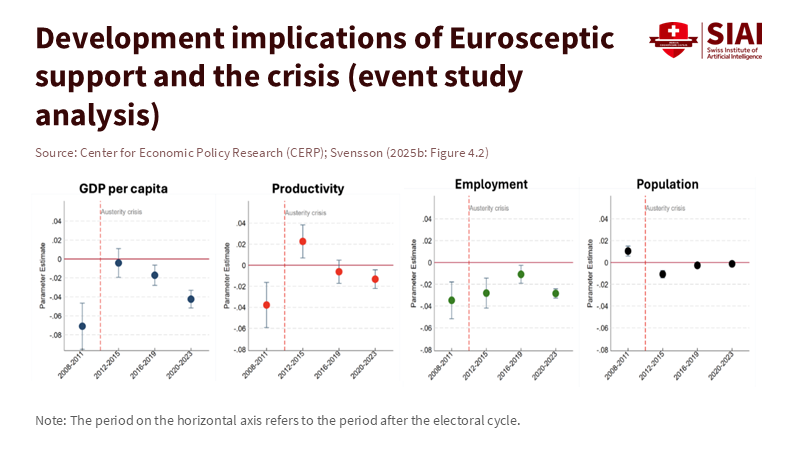Globalization and Jobs: why “left-behind” places produce angry politics, not just lower GDP
Input
Modified
Globalization shifts tasks to cheaper hubs while people move unevenly Left-behind places lose jobs and grow politically angry Insure workers, boost mobility, and invest in local productivity

The narrative about regional backlash is too narrow. We often say that places unhappy with integration underperform, and then we blame their anger for this underperformance. This flips the causation. Let’s start with a key fact. In 2024, average hourly labor costs in the European Union varied from €10.6 in Bulgaria to €55.2 in Luxembourg, a five-fold difference within a single market with little friction. Companies respond to such gaps, and so do workers. When capital, contracts, and careers flow to the least expensive or most productive locations, those without portable skills do not move. They stay behind, witness opportunities leave, and vote based on their suffering. This is the crucial link between globalization and jobs, which connects places like Calabria and Kentucky. It’s not just an EU issue. It is a global process that shifts work across borders and the most mobile individuals within countries, leaving less mobile communities to deal with the fallout and then be blamed for it. However, there is hope. Policy solutions can mitigate these disparities and pave the way for a more equitable future.
Reframing the map around globalization and jobs
We need a straightforward perspective on globalization and jobs. Global markets now link local labor markets. The EU's single market has reduced barriers to hiring and job placements across borders. In 2022, there were about 4.6 million instances of workers being posted across borders within the EU, and around 1.8 million people crossed national borders daily for work. This is efficient for companies. It also serves as a daily reminder in high-cost regions that competitors can be flown, bused, or logged in. Globalization and jobs interact through unequal mobility: capital and skilled workers move quickly; mid-skill and low-skill workers move the least. The effect is not just that angry places grow more slowly; it is that selection effects hollow them out first, making them appear “underperforming.” This is why prosperous hubs like Frankfurt or Amsterdam attract the “winners.” At the same time, regions in southern Italy or eastern Europe lose them. The geography of resentment follows the geography of mobility. A straightforward perspective is crucial in understanding the complexities of this issue.
Outside of Europe, we see a similar pattern. In the U.S., suburbs absorbed much of the rise in poverty after the pandemic, even as national averages improved. Meanwhile, research shows links between import competition, offshoring, and shifts in regional politics. Areas more exposed to trade shocks have leaned toward protectionist politics. This does not mean all discontent stems from trade; it indicates that the distribution of pain matches the distribution of votes. The mechanism is precise: when an industry’s value chain globalizes, local wage premiums drop first in areas where skills are less portable, housing is more challenging to sell, and networks are more regional than global. Globalization and jobs sort households and towns, not just companies.

What the data say, from the EU to the U.S.
The incentive to seek cheaper labor within Europe is striking. Eurostat estimates that average hourly labor costs in the EU were €33.5 in 2024, but ranged from €10.6 in Bulgaria to €55.2 in Luxembourg. From 2023 to 2024, costs increased about 5% across the EU, but the ranking of cheap versus expensive labor barely changed. Companies in tradable sectors do what they have always done: they move routine tasks to lower-cost locations and keep higher-skilled roles in high-wage hubs. The result for the company is more output per euro. Still, it can create social problems for the areas that previously hosted those routine jobs. Globalization and employment collide here, and this collision is structural, not cyclical.
Regarding mobility, the European Commission’s latest report on internal EU labor movement confirms the scale and normality of cross-border work. Millions of job postings each year and daily cross-border commutes have returned to above pre-pandemic levels. The economic argument is clear: the single market improves efficiency. However, the political argument is more complex. Every posted worker symbolizes that a job once seen as “local” has become European. This symbolism resonates in places already losing young graduates to larger cities. The issue with globalization and employment is not foreigners “taking” jobs. It is the shrinking local opportunity ladder when local businesses can source talent from anywhere, and when the most mobile locals have already left.

In the U.S., studies show that exposure to import competition changed local labor markets and politics. While the initial “China shock” findings are older, dating back to the early 2000s when China's entry into the World Trade Organization led to a surge in Chinese imports, newer analyses reinforce the core conclusion: regions exposed to trade have experienced lasting job and wage declines, and have become more open to divisive messages and political parties. A new post-pandemic reality is that the suburban areas, once symbols of middle-class stability, now host a growing number of poor residents. This challenges the notion that only “big cities” deal with distress and expands the political impact of economic grievances. Globalization and jobs now tie the futures of suburban logistics parks and small-town factories to platform work located far away.
How the mechanism works: an update for the digital age
Textbooks taught us that once barriers fall, economies specialize according to their resources. In reality, a twist of the 2020s is that it's tasks, not just goods, that move. Offshoring and global production sharing increase demand for skills in receiving countries and push routine tasks to lower-cost areas. Recent OECD research reviews extensive studies and finds that low-skilled workers generally lose out from offshoring while high-skilled workers benefit. The updated channel for globalization and jobs is not just about container ships; it involves cloud platforms, code repositories, and cross-border teams. Factor-price pressures remain, but they now occur through “task price equalization,” a concept in which tasks like coding, claims processing, or CAD drafting can be separated, making price competition global by default.
Follow the money. In 2023, ASEAN attracted about $230 billion in foreign direct investment, maintaining its status as the top investment destination among developing regions. Japanese companies report their most significant expansion plans in India and ongoing interest in Vietnam and Southeast Asia’s supply chains. South Korean investors are crucial to Vietnam’s electronics development. These investments do not “take” prosperity from developed regions; they integrate them. However, they also reduce demand for mid-wage routine jobs in cities that once depended on local manufacturing and back-office work. As companies expand globally, communities may see their tax bases shrink at home. This illustrates how globalization and job creation can boost national productivity while sparking local resentment.
The service sector is also involved. India's technology industry is expected to generate a quarter-trillion dollars in revenue, and global capability centers in India alone are projected to grow from about $65 billion in 2024 to nearly $100 billion by 2030. U.S. companies across sectors, from finance to retail, are hiring thousands of engineers in cities like Bengaluru and Hyderabad. While this is often seen positively, it compresses earnings in advanced economies where clerical speed or routine software maintenance used to be a strength. Thus, the pressure from globalization and jobs extends beyond manufacturing. The moment a county loses its last mid-wage office complex, its political landscape shifts.
The trends in inequality add another layer. Over the last two decades, inequality between countries has decreased slightly as large emerging economies have grown. Still, inequality within countries has increased in many areas. The World Inequality Lab’s 2024 report and supporting academic studies indicate that the days of easy convergence are behind us, with domestic disparities becoming the main fault lines. This aligns with what a sorting model predicts. Mobile individuals and industries concentrate in a few hubs, while others compete on costs or subsidies. Angry politics, then, is not a flaw of globalization; it is a by-product of who can move and who cannot. Globalization and jobs connect larger economic trends to localized voting behavior.
Policy that helps: ensure support for people, connect places, raise productivity where people live
If the issue is selection and sorting, then blaming voters accomplishes nothing. We need policies that protect people from shocks, connect them to growing markets, and improve productivity in their communities without reviving outdated industries. This begins with tangible support for mobility. In Europe, the Single Market itself is a tool for productivity. However, the OECD notes that deeper integration in capital, labor, and services is still needed to spread the benefits. Speeding up the recognition of qualifications, ensuring portable pensions, and simplifying cross-border hiring can reduce the pain of relocation. This can make globalization and jobs feel less like a zero-sum game for those outside the big hubs.
Support must be personal, not just regional. Wage insurance that temporarily supplements earnings after a job loss has strong theoretical backing and practical promise in a world where tasks, not firms, move. This should be coupled with legitimate retraining focused on the green and digital transitions noted in the 2024 Employment Outlook. Where moving is infeasible, subsidize local commuting options—such as reliable regional rail, broadband for remote work, and apprenticeships created in collaboration with businesses in nearby growing areas. Move people closer to work or bring work closer to people; the objective is to decrease the distance between them. On the public investment front, EU cohesion funding should focus on meaningful, long-term productivity improvements. Mixed evidence regarding the growth effects of cohesion spending should direct us toward projects that boost tradable-sector output per worker rather than merely enhancing local aesthetics. Policies surrounding globalization and jobs should prioritize mobility and productivity metrics first.
Finally, we should steer clear of romanticized protectionism. A wave of analysis in 2024-25 cautions that populist economics—such as tariffs, politicized credit, and attacks on independent courts—typically leads to lower incomes over time. The right approach to offshoring isn’t to prohibit it, but to negotiate for domestic advantages: keep research jobs local when routine tasks shift overseas, require suppliers to include certified small businesses from struggling areas, and tie public procurement to apprenticeships sourced from neglected regions. Trade and technology diffusion can increase national wealth. It’s our job to ensure they also enhance local earnings. That is how globalization and jobs can transform from threats into promises.
The five-fold wage gap within the EU is not a moral failing. It serves as an incentive. Companies pursue it, while workers deal with its consequences. When the ability to move is uneven, and tasks can cross borders faster than families can relocate, the landscape divides. Prosperity and educated individuals gather in specific areas, while routine work becomes scattered. We mistakenly interpret the consequences—slower economic growth in discontented regions—as the cause. The real reason is the sorting system we’ve established. The solution is not to dismantle this system but to equip it with better shock absorbers and broader access routes. Protect individuals, not just locations. Connect towns to nearby jobs or bring remote work opportunities to them. Focus funding on productivity rather than nostalgia. And expand the Single Market to promote upward mobility, not just out-migration. If we can implement these unglamorous solutions, the same forces of globalization and jobs currently fueling backlash can help rebuild trust. The statistic mentioned earlier will still hold true, but it will no longer define where anger resides or how vocally it expresses itself.
The views expressed in this article are those of the author(s) and do not necessarily reflect the official position of the Swiss Institute of Artificial Intelligence (SIAI) or its affiliates.
References
Autor, D., Dorn, D., & Hanson, G. (2016). The China Shock: Learning from Labor-Market Adjustment to Large Changes in Trade. Annual Review of Economics. (Evidence base summarized by VoxEU and related NBER papers cited in article.)
Brookings Institution. (2023, October 11). Post-pandemic poverty is rising in America’s suburbs.
European Commission. (2025, February 7). Annual report on intra-EU labour mobility 2024 published.
Eurostat. (2025, March 28). EU hourly labour costs ranged from €11 to €55 in 2024.
JETRO. (2024, November 28). Survey on Business Conditions of Japanese-Affiliated Companies in Asia and Oceania 2024.
Le Monde. (2024, May 10). Europe’s regional inequalities fuel anger and despair. https://www.lemonde.fr.
OECD. (2024, July 1). Employment Outlook 2024. Paris: OECD.
OECD. (2025, July 3). Economic Surveys: European Union and Euro Area 2025—Strengthening productivity and the Single Market. Paris: OECD.
OECD. (2024, April 23). Offshoring, Reshoring, and the Evolving Geography of Jobs. Paris: OECD.
Reuters. (2024, September 11). India’s global capability centre market to grow to $105 bn by 2030. https://www.reuters.com.
Reuters. (2025, January 23). U.S. fintech firm Broadridge to boost India headcount by 26%. https://www.reuters.com.
UNCTAD. (2024). FDI inflows to ASEAN reach $230 bn in 2023.
World Inequality Lab. (2024, November). Global Inequality Update 2024: Technical Note. Paris School of Economics.
World Inequality Lab / Kanbur, R. (2024). Is the era of declining global income inequality over? Structural Change and Economic Dynamics.






















Comment